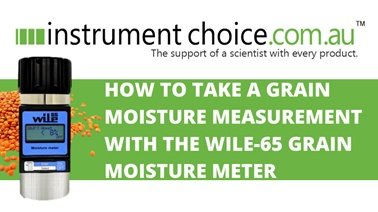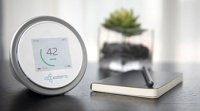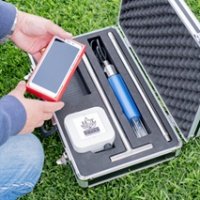How to Take a Grain Moisture Measurement with the Wile-65 Grain Moisture Sensor

The Wile-65 Moisture Sensor is a practical tool for the fast and accurate determination of moisture content in various grain and seeds. The unit has calibration curves pre-programmed for 16 Australian grains.
Figure 1 Watch a scientist demonstrate how to take a moisture measurement with the Wile-65 grain moisture sensorhere .
Materials
- Wile-65 Grain Moisture Sensor
- Measuring cup (Included with Wile-65)
- Grain of choice (See appendix 1 for compatible grains).
How to Take a Grain Moisture Measurement with the Wile-65 Grain Moisture Sensor
TAKING A REPRESENTATIVE SAMPLE
When taking moisture measurements of grain, you must take a representative sample to ensure your results accurately represent the moisture content of the entire batch. Our scientists have listed three tips to help you ensure grain sampling accuracy:
- Take multiple samples from different places in the load or batch
- Remove any scrap, greenery, and defective grains; and
- Take a minimum of five measurements and calculate the average value to obtain a final moisture content reading.
PRE-PROGRAMMED GRAIN SELECTION
- Press the ON/OFF key to switch on the Wile-65.
- Press the MENU key to cycle through the main menu until you reach the screen that reads “GRAIN”.
- Press ON/OFF to enter into grain settings.
- The current grain selection will display in the centre of the LCD. To cycle through the grain choices, press the MENU button.
- When your required grain is on the screen, press ON/OFF to select.
- The device will save this setting and then return to the main menu. Press the MENU key to cycle through the main menu until your chosen grain displays on the LCD. The Wile-65 is ready to take measurements.
TAKING A MEASUREMENT
- Fill the measuring cup to around 1/4 full with your grain sample.
- Unscrew and remove the lid of the moisture sensor to reveal the sample stage.
- Pour in the grain to be measured. As you pour in the grain, give the meter a slight shake to help settle the grain.
- Fill the sample stage to the brim. Once filled, level and wipe off the excess grain.
- Replace the lid of the moisture sensor and twist to tighten. Continue to tighten the cap until the silver circle in the centre is the same level as the surface of the lid. See figure 1 below for an example of the lid before and after being secured correctly.

Figure 1 The Wile-65 lid before and after being secured correctly.
- With your selected grain displaying on the LCD, press ON/OFF to begin a moisture test.
- Within a couple of seconds, the measurement is complete. The screen will display the sample temperature, sample measurement mode and moisture percentage.

Figure 2 When a moisture measurement is complete, the screen will display the sample temperature, sample measurement, and moisture percentage.
- Repeat steps 1 to 8 five times and average the result for the most comprehensive overview of the moisture content of your product.
Conclusion
The WILE-65 is a highly popular grain moisture meter thanks to its versatility, portability and most of all, ease of use. To take a sample reading, select the grain type, load the grains and press START – that’s it!
For more information on the WILE-65, see the links below or contact us!
Appendix 1
The Wile 65 pre-programmed with 16 Australian grains; additional charts are available for non-programmed grains.
|
Grain |
Moisture Content |
|
Wheat |
8-35% |
|
Corn |
8-35% |
|
Barley |
8-35% |
|
Oats |
8-35% |
|
Canola |
5-25% |
|
Rice |
8-35% |
|
Sorghum |
8-30% |
|
Lupin |
8-35% |
|
Triticale |
8-35% |
|
Linseed |
5-25% |
|
Soya Beans |
5-25% |
|
Oil Seed Sunflower |
4-35% |
|
Green Lentil |
8-25% |
|
Red Lentil |
8-35% |
|
Field Pea |
8-35% |
|
Desi Chickpea |
8-25% |
Additional links
- View the Wile-65 Grain moisture sensor for harvesting, drying and storing here
- Watch “How to Take a Grain Moisture Measurement with the Wile-65 Grain Moisture Sensor” again
- Want to see what comes in the box? Watch an Instrument Choice Scientist “Unboxing the Wile-65 Grain moisture sensor for harvesting, drying and storing “.
- Browse all Grain-Hay Moisture Sensors at Instrument Choice

Also interesting
Air quality is the sum of several characteristics that can affect a person's health and wellbeing. This article discusses how overall air quality is measured and highlights typical product examples, including notable features and applications.

Soil Moisture sensors are a practical, quick and effective tool for monitoring soil moisture content out in the field. This article investigates four types of soil moisture sensors and how they work.

